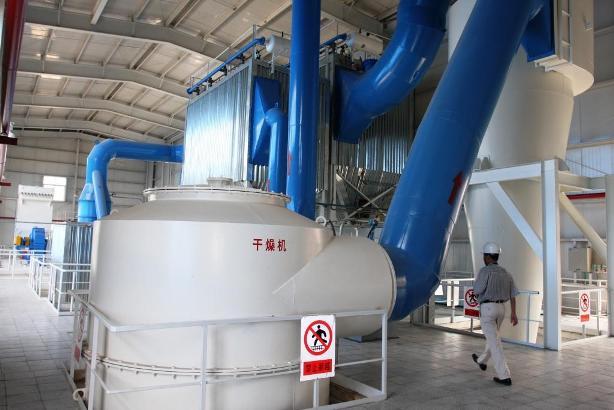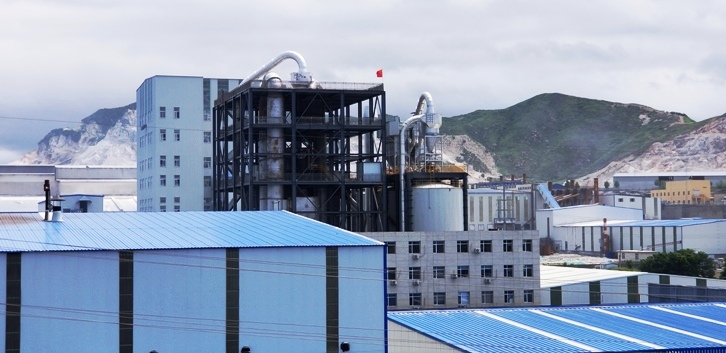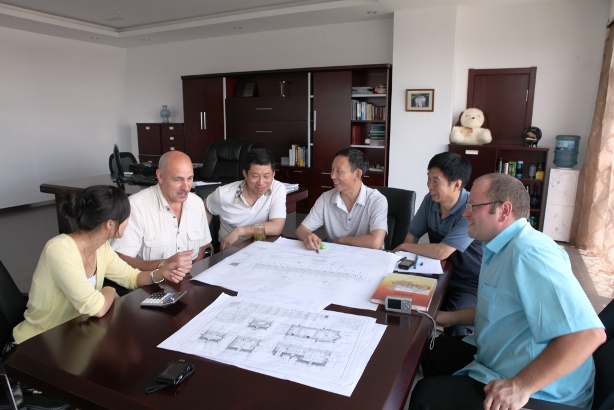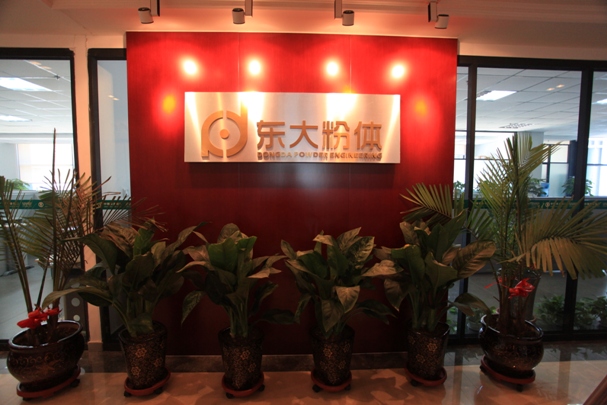Research on new technology of flash roasting of boron ore powder
Zhang Jiyu1, Cheng Ju2, Li Zonglin2, Xiao Rong1
(1. Northeastern University, Shenyang, Liaoning, 110004; 2. Liaoning Dongda Powder Engineering Technology Co., Ltd., Shenyang, Liaoning, 110015)
Abstract: To produce borate products from boron mafic ore, iron concentrates are usually selected first, and then boron-containing tailings are processed into powdered boron concentrates. When the boron ore is processed by the alkali method, the boron ore must be roasted to improve the activity of boron trioxide. In this paper, a new flash roasting process of low-grade boronite, which organically combines pre-drying and activation roasting, is proposed. On the basis of laboratory test and industrialized production, a comprehensive evaluation of this process was carried out, and corresponding improvement plans were proposed for its shortcomings. This process is efficient and feasible, and the activation rate of boron mafic ore can be increased to more than 85%~90% under a certain grade. It has played an important demonstration role for the comprehensive utilization of low-grade boron-mafic iron ore in Liaoning Province and even the whole country.
Key words: boronite; flash roasting; activation rate; process equipment
1 Preface
Some boron compounds have special properties such as light weight, flame retardant, heat resistance, high hardness, high strength, wear resistance and catalysis, and play an extremely important role in modern industry and research fields. Boron and boron compounds are widely used in chemical industry, metallurgy, optical glass, national defense, atomic energy, medicine, rubber and light industry sectors.
At present, the proven reserves of boron ore in my country are about 50 million tons (calculated as B2O3), and the grade is low. Half of them are mixed ore of boronite and ferroboron, and the reserves of salt brine and solid boron ore of salt lake are about 20 million tons, which are easy to process. The main boronite ore in China is "white boron ore", which only accounts for 8.98% of the country's total reserves, less than 3 million tons. According to statistics and forecasts of relevant departments, the demand for borax and boric acid will increase by 6.25% and 6.50% respectively in the next few years. By 2010, the demand for borax, boric acid and other boron-containing chemicals in my country will exceed 500,000 tons. The demand for standard ore) is 2.2 million tons, which will cause the supply and demand situation of boronite ore to become more and more severe, and it is urgent to develop new boron resources to meet the growing industrial demand [1]. Therefore, "black boron ore" (ie, boron iron ore), which has a reserve of 280 million tons and accounts for 57.88% of my country's boron ore resources, has become the main object of comprehensive utilization of boron ore resources.
The main problem of activation roasting of boronite is that roasting is difficult to control and its activity is poor. The activity of boron in raw ore is about 40%[2], and the activity of boron iron concentrate after roasting is generally ≤70%. Therefore, a reasonable roasting process and equipment must be designed to efficiently utilize boron ore resources.
2 Analysis of the roasting process of boron ore powder
The chemical activation rate of raw ore powder without roasting activation is very low. For example, under the condition that the excess alkali is about 50% and the alkali concentration is about 30%, the normal pressure alkaline hydrolysis rate of raw ore powder of Fengcheng boron-magnesium ore is only 30%~40%; and the alkaline hydrolysis rate of cooked ore powder can be more than 80%. After the boron-magnesium ore is roasted, the crystal structure of the mineral changes, the texture is loose and porous, and the chemical activity is significantly improved, so that the B2O3 in the ore is easier to be leached by the decomposer. For this reason, the production of borax or sodium polyborate by the carbon-alkali method, the caustic soda method, and the production of boric acid by the carbon-ammonia method all require activation and roasting of the boron ore. The quality of roasting plays a decisive role in the decomposition rate. At the same time, when roasting moderate ore, the hardness is reduced, the texture is crunchy, and it is easier to crush. Therefore, in industrial production, it is necessary to strive to improve the roasting quality, prevent raw burning, and avoid overburning.
2.1 Roasting mechanism of boron mafic ore
In addition to fibrous boronite, boron-magnesium ore also contains associated minerals such as serpentine, dolomite, magnesite, calcite, brucite, olivine, talc, lime chlorite and mica. The origin of the ores is different, and the types and quantities of associated minerals are also different [3].
The main physicochemical changes affecting the activity of boron mafic during roasting are as follows[4,5]:
When heated to 300~400℃, the oxidation of magnetite to hematite causes the distortion of the mineral structure and the increase of microcracks, which increases the specific surface area, that is, increases the reaction area during alkaline hydrolysis, thereby increasing the activity of B2O3.
4Fe3O4+O2=6Fe2O3
At 500~750℃, the dehydration and decomposition of serpentine resulted in the appearance of a large number of micropores, which further increased the specific surface area. The main reaction is:
Mg3Si4O11·3Mg(OH)2·H2O=Mg3Si4O11·3Mg(OH)2+H2O↑
Mg3Si4O11·3Mg(OH)2=Mg3Si4O11+3MgO+3H2O↑
When the calcination temperature reaches 620~800℃, the fibrous boronite (2MgO·B2O3·H2O), which is not easy to be alkali-hydrolyzed, is converted into the easily alkali-hydrolyzed suianite (MgO·B2O3), which increases the activity of B2O3, but the calcination temperature reaches 900 After ℃, the amount of suianite decreased, and the activity also showed a downward trend. The main reaction is:
2MgO·B2O3·H2O=2MgO·B2O3+H2O↑
When the roasting temperature rises to over 800℃ and the roasting time is too long, part of B2O3 will form boron mafic ore (3MgO·Fe3O4·B2O3) which is difficult to be hydrolyzed by alkali, and then the activity of B2O3 will decrease.
After roasting, the volume density of boron concentrate decreases (about 5%), which indicates that the porosity in the ore powder increases, which is beneficial to the contact between alkali and B2O3, and improves the activity of B2O3.
In the above changes, the decomposition of fibrous borosite is the main chemical reaction of dehydration of boron ore powder [6].
2.2 The existing domestic boron ore powder roasting and calcining process and equipment
There are about 16 large enterprises producing boron ore in my country, mainly concentrated in Liaoning, with a total of 11 [7]. At present, there is no advanced industrial equipment for the roasting of low-grade boron iron ore, and most enterprises discard it, resulting in a lot of waste of resources and environmental pollution [8]. A few manufacturers use rotary kiln as the roasting equipment for boron ore powder. The products obtained by roasting in rotary kiln usually have low activation rate and leaching rate, high coal consumption, poor thermal efficiency, and it is difficult to make good use of boron ore resources.
Some companies have tried to use fluidized roasting, but because boron ore contains 20% to 30% of surface water, its application has been greatly hindered. Many domestic experts and researchers are looking for suitable solutions.
3 New flash roasting process
3.1 Flash Roasting Process
The boron mafic ore in Fengcheng area of Liaoning is a low iron and low boron lean impurity ore. Its mineral composition is as follows: boron trioxide (B2O3) 8%-10%, total iron (TFe) 24%-28%, Magnesium oxide (MgO) 25% to 28%, silicon dioxide (SiO2) 18% to 21%, calcium oxide (CaO) 1% to 2%.
Liaoning Dongda Powder Engineering Technology Co., Ltd. (hereinafter referred to as Liaoning Dongda Powder Company) cooperated with Fenghua Group to conduct a large number of experiments and researches on the difficult control and poor activity of low-grade boron iron ore activation roasting. The new flash roasting process that organically combines pre-drying and roasting, the activation rate of the finished product after roasting is obviously higher than that of the product roasted by the traditional rotary kiln. For example, boronite with a grade of more than 10% can be roasted to an activation rate of over 90%; boronite with a grade of 6% to 10% can be roasted to an activation rate of 80 to 85%. The principle process flow is shown in Figure 1, and the process device is shown in Figure 2.
The specific process is: use the feeder to feed the undried boron ore powder into the Sder dryer, the boron ore powder is pre-dried in the dryer, and the heat source for drying is the hot tail gas generated by the subsequent roasting process; after drying The mixture of material and air enters the gas-solid separator for gas-solid separation, the gas part is discharged, and the solid part is sent to the calciner for activation and roasting. The required temperature is about 900~950℃); the mixture of material and air after roasting is sent to another gas-solid separator for another gas-solid separation, in which the gas part is sent to the dryer as a drying heat source, and the solid part is sent to the dryer as a drying heat source. After cooling, the finished product is collected, namely boron ore powder with high activation rate. After the above-mentioned process was confirmed, Liaoning Dongda Powder Co., Ltd. cooperated with the Weathering Group to determine the construction of a roasting and drying production line with an annual output of 50,000 tons, and put it into operation.
Fig. 2 Boron ore powder flash roasting process device
1-Feeder, 2-Side dryer, 3-Gas-solid separator, 4-Calciner, </>
5—Hot blast stove, 6—Finished product catcher, 7—Storage bin, 8—Induced draft fan
3.2 Industrial production data analysis
Considering the lowest energy consumption per ton of boron ore products, a coal-fired direct-fired hot blast stove is used as the roasting heat source in the weathering project. The thermal energy utilization rate of coal can reach more than 90%. Another energy utilization method adopted is to directly enter the exhaust gas from the decomposition of the calcined boron ore powder in the calciner into the drying system, so that the exhaust gas temperature is slightly higher than the dew point temperature of SO2. In the laboratory test, the designed roasting temperature is 900~950℃, but under the actual industrial production conditions, the most suitable roasting temperature is found to be 1000~1050℃. The industrial production results are shown in Table 1.
The data measured from the production run are as follows:
Coal consumption per ton of product: 150~160 kg; electricity consumption: about 46 kWh/ton of product;
Product loss on ignition: ≤3%; Hourly output of boron concentrate: ≥6.25 tons.
In the above system, if proper adjustment is made, the energy consumption can also be reduced and the output can be greatly increased.
The above-mentioned industrial production results show that, compared with the existing domestic low-grade boron ore roasting process, this process ultimately improves the activation rate of low-grade boron ore. There are two reasons for the analysis: First, in this process, due to the dispersing effect of the Sder dryer, the boronite is processed to a certain fineness before roasting, which increases the specific surface area of the boronite, which is beneficial to the Instantaneous roasting; secondly, in the process of pre-drying and activation roasting, the materials do a tossing and swirling motion in the equipment, so that the roasting effect is sufficient and uniform.
4 Conclusion
Production has proved that compared with other methods, this process can greatly improve the activation rate of boronite, and has the following advantages:
(1) The operation is convenient, the roasting time is short, and the whole process is completed within a few seconds to tens of seconds;
(2) The total energy consumption is low because the hot tail gas produced by roasting is recycled;
(3) The product has high activity. When the B2O3 grade of boron powder is ≥7.5%, the roasting activity can reach 80%~90%;
(4) It has exhaust gas purification device, which has little pollution to the environment;
(5) The equipment occupies a small area and is easy to maintain.
In the actual production process, it is also found that this set of process equipment has the following shortcomings:
The laboratory test shows that the required maximum roasting temperature is 900~950℃. The original machine-fired hot blast stove was designed with reference to this temperature range, but the roasting temperature in actual production is 1000~1050℃. At this time, the hot blast stove is In the production process, the life is shortened, and it is prone to failure.
In view of this deficiency, Liaoning Dongda Powder Co., Ltd. proposed the following corresponding improvement plans.
Option 1: Renovate the structure of the coal-fired hot blast stove to improve its heat resistance and adapt to a high temperature environment of about 1200°C;
Option 2: Use the gas combustion produced by the gas generator as the heat source, which can reduce the failure rate of the machine-fired hot blast stove. However, compared with coal-fired hot blast stoves, the heat utilization rate of gas hot blast stoves is lower (about 10%~15% lower). This is because there will be a certain amount of heat loss in the process of converting coal into gas, and the heat utilization rate of coal-fired hot blast stoves can reach more than 90%, while the heat utilization rate of coal-fired hot blast stoves can only reach 75~80% ;
Option 3: Use a hot blast stove that burns pulverized coal, which can not only generate a high enough temperature, but also better prevent the failure caused by the overheating of the hot blast stove. Coal powder with low ash content can be used to control the dust level to about 2~3%.
In addition to the above adjustments in the heat source, there can also be improvements in the optimal design.
参考文献 references
[1]杨芃卉,李琦,王秋霞.铁硼矿的综合利用新工艺研究[J].中国资源综合利用,2002(9):12-15.
[2]刘然,薛向欣,黄大威.硼铁矿氧化焙烧失重及机理探讨[J].钢铁,2007(9):9-11.
[3]郎建峰等.低品位铁矿化工冶金性能及开发利用[J].矿产综合利用,1997(2):5-9
[4]郑学家主编.硼化合物生产与应用[M].北京:化学工业出版社,2007.10.
[5]赵庆杰,何长清,高明辉.硼铁矿综合利用——硼精矿活化及含硼铁精矿改善烧结球团性能的机理[J].华东冶金学院学报,1997(3):262-266.
[6]崔传孟,刘素兰,张显鹏.硼铁矿氧化焙烧试验研究[J].矿冶,1995(4):78-81.
[7]郑学家,张吉昌.硼和全国硼工业手册[M],中国化工学会无机盐酸碱盐专业委员会硼化物专家组,2005.
[8]吴学英,潘晓杰.硼精粉挤压成形焙烧技术分析[J].无机盐工业,2008(2):36、37、59.
[9]HamiltonS.Boron[J].MiningEngineering,2004,56:15-16.

 Our Mission/ Create a national brandCore Value/ Focus, Active, Diligent, Extreme
Our Mission/ Create a national brandCore Value/ Focus, Active, Diligent, Extreme Our Mission/ Create a national brandCore Value/ Focus, Active, Diligent, Extreme
Our Mission/ Create a national brandCore Value/ Focus, Active, Diligent, Extreme





 Chinese
Chinese


